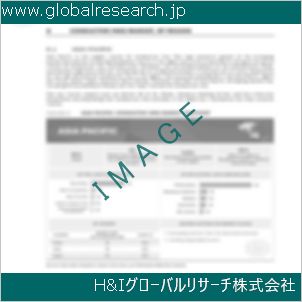Table of Contents
1 Industry Overview of Thorium
1.1 Definition and Specifications of Thorium
1.1.1 Definition of Thorium
1.1.2 Specifications of Thorium
1.2 Classification of Thorium
1.3 Applications of Thorium
1.3.1 Nuclear Application
1.3.2 Non-Nuclear Application
1.4 Industry Chain Structure of Thorium
1.5 Industry Overview and Major Regions Status of Thorium
1.5.1 Industry Overview of Thorium
1.5.2 Global Major Regions Status of Thorium
1.6 Industry Policy Analysis of Thorium
1.7 Industry News Analysis of Thorium
2 Manufacturing Cost Structure Analysis of Thorium
2.1 Raw Material Suppliers and Price Analysis of Thorium
2.2 Equipment Suppliers and Price Analysis of Thorium
2.3 Labor Cost Analysis of Thorium
2.4 Other Costs Analysis of Thorium
2.5 Manufacturing Cost Structure Analysis of Thorium
2.6 Manufacturing Process Analysis of Thorium
3 Technical Data and Manufacturing Plants Analysis of Thorium
3.1 Capacity and Commercial Production Date of Global Thorium Major Manufacturers in 2023
3.2 Manufacturing Plants Distribution of Global Thorium Major Manufacturers in 2023
3.3 R&D Status and Technology Source of Global Thorium Major Manufacturers in 2023
3.4 Raw Materials Sources Analysis of Global Thorium Major Manufacturers in 2023
4 Capacity, Production and Revenue Analysis of Thorium by Regions, Types and Manufacturers
4.1 Global Capacity, Production and Revenue of Thorium by Regions 2019-2024
4.2 Global and Major Regions Capacity, Production, Revenue and Growth Rate of Thorium 2019-2024
4.3 Global Capacity, Production and Revenue of Thorium by Types 2019-2024
4.4 Global Capacity, Production and Revenue of Thorium by Manufacturers 2019-2024
5 Price, Cost, Gross and Gross Margin Analysis of Thorium by Regions, Types and Manufacturers
5.1 Price, Cost, Gross and Gross Margin Analysis of Thorium by Regions 2019-2024
5.2 Price, Cost, Gross and Gross Margin Analysis of Thorium by Types 2019-2024
5.3 Price, Cost, Gross and Gross Margin Analysis of Thorium by Manufacturers 2019-2024
6 Consumption Volume, Consumption Value and Sale Price Analysis of Thorium by Regions, Types and Applications
6.1 Global Consumption Volume and Consumption Value of Thorium by Regions 2019-2024
6.2 Global and Major Regions Consumption Volume, Consumption Value and Growth Rate of Thorium 2019-2024
6.3 Global Consumption Volume and Consumption Value of Thorium by Types 2019-2024
6.4 Global Consumption Volume and Consumption Value of Thorium by Applications 2019-2024
6.5 Sale Price of Thorium by Regions 2019-2024
6.6 Sale Price of Thorium by Types 2019-2024
6.7 Sale Price of Thorium by Applications 2019-2024
6.8 Market Share Analysis of Thorium by Different Sale Price Levels
7 Supply, Import, Export and Consumption Analysis of Thorium
7.1 Supply, Consumption and Gap of Thorium 2019-2024
7.2 Global Capacity, Production, Price, Cost, Revenue, Supply, Import, Export and Consumption of Thorium 2019-2024
7.3 USA Capacity, Production, Price, Cost, Revenue, Supply, Import, Export and Consumption of Thorium 2019-2024
7.4 EU Capacity, Production, Price, Cost, Revenue, Supply, Import, Export and Consumption of Thorium 2019-2024
7.5 China Capacity, Production, Price, Cost, Revenue, Supply, Import, Export and Consumption of Thorium 2019-2024
7.6 Japan Capacity, Production, Price, Cost, Revenue, Supply, Import, Export and Consumption of Thorium 2019-2024
8 Major Manufacturers Analysis of Thorium
8.1 Manufacturer One
8.1.1 Company Profile
8.1.2 Product Picture and Specifications
8.1.2.1 Type I
8.1.2.2 Type II
8.1.2.3 Type III
8.1.3 Capacity, Production, Price, Cost, Gross and Revenue
8.1.4 Contact Information
8.2 Manufacturer Two
8.2.1 Company Profile
8.2.2 Product Picture and Specifications
8.2.2.1 Type I
8.2.2.2 Type II
8.2.2.3 Type III
8.2.3 Capacity, Production, Price, Cost, Gross and Revenue
8.2.4 Contact Information
8.3 Manufacturer Three
8.3.1 Company Profile
8.3.2 Product Picture and Specifications
8.3.2.1 Type I
8.3.2.2 Type II
8.3.2.3 Type III
8.3.3 Capacity, Production, Price, Cost, Gross and Revenue
8.3.4 Contact Information
8.4 Manufacturer Four
8.4.1 Company Profile
8.4.2 Product Picture and Specifications
8.4.2.1 Type I
8.4.2.2 Type II
8.4.2.3 Type III
8.4.3 Capacity, Production, Price, Cost, Gross and Revenue
8.4.4 Contact Information
8.5 Manufacturer Five
8.5.1 Company Profile
8.5.2 Product Picture and Specifications
8.5.2.1 Type I
8.5.2.2 Type II
8.5.2.3 Type III
8.5.3 Capacity, Production, Price, Cost, Gross and Revenue
8.5.4 Contact Information
…
9 Marketing Trader or Distributor Analysis of Thorium
9.1 Marketing Channels Status of Thorium
9.2 Traders or Distributors with Contact Information of Thorium by Regions
9.3 Ex-work Price, Channel Price and End Buyer Price Analysis of Thorium
9.4 Regional Import, Export and Trade Analysis of Thorium
10 Industry Chain Analysis of Thorium
10.1 Upstream Major Raw Materials Suppliers Analysis of Thorium
10.1.1 Major Raw Materials Suppliers with Contact Information Analysis of Thorium
10.1.2 Major Raw Materials Suppliers with Supply Volume Analysis of Thorium by Regions
10.2 Upstream Major Equipment Suppliers Analysis of Thorium
10.2.1 Major Equipment Suppliers with Contact Information Analysis of Thorium
10.2.2 Major Equipment Suppliers with Product Pictures Analysis of Thorium by Regions
10.3 Downstream Major Consumers Analysis of Thorium
10.3.1 Major Consumers with Contact Information Analysis of Thorium
10.3.2 Major Consumers with Consumption Volume Analysis of Thorium by Regions
10.4 Supply Chain Relationship Analysis of Thorium
11 Development Trend of Analysis of Thorium
11.1 Capacity, Production and Revenue Forecast of Thorium by Regions and Types
11.1.1 Global Capacity, Production and Revenue of Thorium by Regions 2024-2029
11.1.2 Global and Major Regions Capacity, Production, Revenue and Growth Rate of Thorium 2024-2029
11.1.3 Global Capacity, Production and Revenue of Thorium by Types 2024-2029
11.2 Consumption Volume and Consumption Value Forecast of Thorium by Regions, Types and Applications
11.2.1 Global Consumption Volume and Consumption Value of Thorium by Regions 2024-2029
11.2.2 Global and Major Regions Consumption Volume, Consumption Value and Growth Rate of Thorium 2024-2029
11.2.3 Global Consumption Volume and Consumption Value of Thorium by Types 2024-2029
11.2.4 Global Consumption Volume and Consumption Value of Thorium by Applications 2024-2029
11.3 Supply, Import, Export and Consumption Forecast of Thorium
11.3.1 Supply, Consumption and Gap of Thorium 2024-2029
11.3.2 Global Capacity, Production, Price, Cost, Revenue, Supply, Import, Export and Consumption of Thorium 2024-2029
11.3.3 USA Capacity, Production, Price, Cost, Revenue, Supply, Import, Export and Consumption of Thorium 2024-2029
11.3.4 EU Capacity, Production, Price, Cost, Revenue, Supply, Import, Export and Consumption of Thorium 2024-2029
11.3.5 China Capacity, Production, Price, Cost, Revenue, Supply, Import, Export and Consumption of Thorium 2024-2029
11.3.6 Japan Capacity, Production, Price, Cost, Revenue, Supply, Import, Export and Consumption of Thorium 2024-2029
12 New Project Investment Feasibility Analysis of Thorium
12.1 New Project SWOT Analysis of Thorium
12.2 New Project Investment Feasibility Analysis of Thorium
13 Conclusion of the Global Thorium (CAS 7440-29-1) Industry 2024 Market Research Report
| ※参考情報 トリウム(Thorium)は、原子番号90の化学元素であり、記号はThで示されます。トリウムは周期表のアクチニウム系列に属し、自然界においてはウランと同様に放射性物質に分類されます。ここでは、トリウムの定義、特徴、種類、用途、そして関連技術について詳しく述べます。 トリウムは、最も一般的には、マグネシウムや硫黄などの鉱石中に微量存在しています。特に、モナズ石やトリウムが含まれる鉱石から主に抽出されます。トリウムは非常に安定しており、特に化学的な性質がウランに似ていますが、より高い安定性を持っています。そのため、トリウムは放射能が比較的低く、環境への影響が少ないという特性を有しています。 トリウムの主な特徴として、強い放射線を発することが挙げられます。しかし、トリウム自体はあまり放射能が強くないため、他の多くの放射性元素と比較して相対的に安全性が高いと評価されています。また、トリウムは核反応を通じてウラン233を生成することができ、この特性が核エネルギーへの利用において注目されています。 トリウムの種類としては、同位体が存在します。主な同位体には、トリウム232(Th-232)があります。Th-232は自然界に豊富に存在し、ウラン233(U-233)への変換に利用されることが多いです。この同位体変換は、トリウムを燃料として使用する際の主要なプロセスです。 トリウムの用途は幅広く、特にエネルギー分野において注目されています。トリウムは、核燃料としての利用が進められています。トリウムを用いた原子炉は、その高い安全性や放射性廃棄物の低減といった利点から、次世代の核エネルギー源として期待されています。また、トリウムは放射線治療や元素分析、材料科学などの分野でも利用されています。 放射線治療においては、トリウムの放射能特性を利用して、腫瘍などの病変をターゲットにすることが研究されています。トリウムの同位体を用いた医療技術は、特に診断や治療の精度向上に貢献することが期待されています。また、トリウムは光ファイバーやセラミックス、さらには自動車の部品などの製造にも利用されています。その耐熱性や化学的安定性により、高性能な材料として評価されています。 トリウムに関連する技術として注目されているのが、トリウム燃料サイクルです。これは、トリウムを核燃料として使用し、その燃焼過程で生成されるウラン233を再利用するサイクルです。このプロセスには、従来のウラン燃料サイクルとは異なる特性があり、より効率的かつ環境への負荷が少ない電力生成が可能になります。トリウム燃料サイクルは、放射性廃棄物の生成量を削減し、長期間の安全な燃料供給を実現する一つの方法として研究が進められています。 さらに、トリウムを使用した原子炉には、加圧水型炉や沸騰水型炉のような他の設計と同様の利点があります。トリウムを用いた炉は、固体燃料を使用するため、運転中の安全性が高く、火災や爆発のリスクが低減されます。また、トリウムを燃料とする原子炉は、核兵器に転用される可能性が極めて低いという特性を持つため、核拡散のリスクを減少させるとされています。 しかし、トリウム燃料サイクルにはいくつかの課題も存在します。トリウムを商業ベースで使用するための技術開発が未だ進行中であり、経済性や技術的な問題が解決される必要があります。たとえば、トリウムの精製技術や加工技術の向上が求められています。また、トリウムを核燃料として利用するための適切な原子炉設計や運用方法についても、多くの研究が行われています。 トリウムは、古代から様々な文化で利用されてきましたが、近年のエネルギー問題や環境問題に対する対応として再注目されています。持続可能なエネルギー供給の観点からも、トリウムを利用した核エネルギー技術が開発されることで、未来の電力供給の選択肢となる可能性があります。 結論として、トリウムは、エネルギー分野をはじめとする多くの産業において重要な材料であり、今後の技術発展によって更なる利用が期待されます。トリウムを活用することで、持続可能な社会の実現や環境保護の一助となることができるでしょう。 |
❖ 免責事項 ❖
http://www.globalresearch.jp/disclaimer












